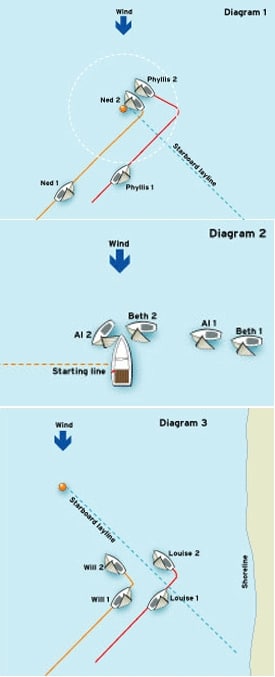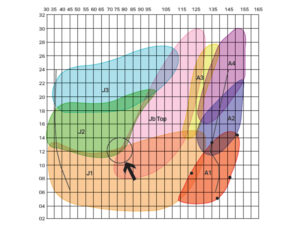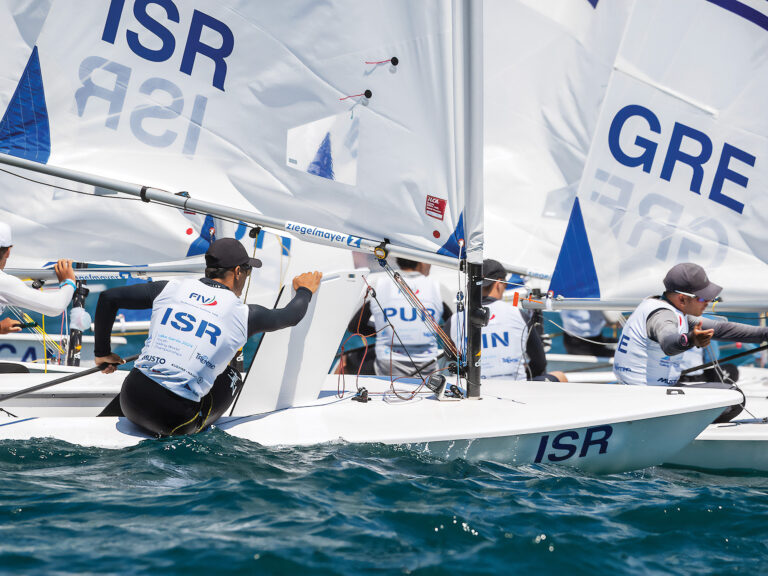
RoseRules2
Editor’s note: Interpretations and opinions expressed in the following article, originally published in Sailing World, are those of the author. This material may not be republished without permission of the author. To obtain an official US Sailing interpretation of a racing rule, you must follow the process set out in Rule 70.3 and Appendix F in the US Sailing Rulebook. The Racing Rules of Sailing go into effect on Jan. 1, 2005, and in the 2005-2008 version of the rulebook there are several important changes that will impact how certain rules apply on the racecourse. In this space last month we began by discussing three changes to the rules that apply when boats meets. Let’s pick up where we left off and discuss the rest of the changes in Rule 18. Rule 18-Rounding and Passing Marks and Obstructions 4. In 2005, the last sentence of Rule 18.2(c) will read, “If the boat that was clear ahead passes head to wind, Rule 18.2(c) no longer applies and remains inapplicable.” The sentence was changed by the addition of the phrase, “and remains inapplicable.” This was done to make it clear that if Rule 18.2(c) applies between two boats while they are approaching a mark, and if that rule is “turned off” by the boat clear ahead turning past head to wind, then Rule 18.2(c) does not apply if Rule 18 is “turned on” later during the same mark rounding. The first diagram shows an example of a situation in which the added phrase is helpful. At Position 1, when Phyllis reaches the two-length zone clear ahead of Ned, Rule 18.2(c) begins to apply. After overstanding slightly, Phyllis turns past head to wind as she tacks to starboard. At that moment, Rule 18 ceases to apply (see Rules 18.1(b) and 18.2(c)) and Rule 13 begins to apply. Rule 13 requires Phyllis to keep clear of Ned until she is on a closehauled course, and she does. As Ned tacks to leeward of Phyllis she bears off slightly. After Ned completes his tack, Phyllis luffs to closehauled and narrowly avoids contact. Under the 2005 rules, Rule 18.2(c) is not “turned on” again after the boats are both on starboard tack. If it had been, Ned would have broken it by failing to keep clear of Phyllis after he completed his tack. The only applicable rules at the time that Phyllis luffs to avoid Ned are Rules 11 and 18.3(a). In this case, neither boat breaks a rule. Rule 11 requires Phyllis to keep clear, and she does. Rule 18.3(a) requires Ned not to cause Phyllis to sail above closehauled, and he does not do so. 5. Rule 18.2(d) will no longer apply before the starting signal. This change is important for match and team racing. The second diagram illustrates a situation that occurs quite often in match and team racing. Here, the committee boat is both a mark and an obstruction. Beth is tailing Al as they circle it 4 minutes before the start. Because the boats are about to pass an obstruction on the same side, Rule 18.2(c) applies. It gives Al right of way. Under new Rule 18.2(d), when Al bears away at Position 2, he must comply with Rule 16.1 and give Beth room to keep clear. Under the 2004 version of Rule 18.2(d) Al did not have to comply with Rule 16.1. Rule 19-Room to Tack at an Obstruction Two important changes have been made to Rule 19. 1. 1. As I pointed in my Oct. ’04 column, there are seven conditions that must be satisfied before a boat approaching an obstruction is entitled to room to tack. One of those-the requirement that the hailing boat be sailing closehauled at the time she hails-has been softened. In 2005, the hail may be made when sailing either closehauled or above closehauled. This change can help avoid serious damage when sailing in a hazardous area. Suppose you’re sailing closehauled in a rocky area and another boat is nearby, on your weather hip. Your crew suddenly notices waves washing over a large rock just ahead and right in your path. In 2004, you had to be sailing closehauled when you hailed for room to tack and you had to hail early enough that the boat on your hip had time to respond before you were forced to tack. In 2005, you can slow your approach to the rock by luffing above closehauled and then hail. The boat on your hip must give you the room you need even though you were above closehauled at the time you hailed. 2. The 2004 version of Rule 19 did not prohibit a boat from hailing for room to tack at a time when she was not entitled to room. As I pointed out in September, a boat that deliberately hailed for room when she was not entitled to it could only be protested under Rule 2, Fair Sailing. However, the 2005 version of Rule 19.1 prohibits a boat from hailing for room to tack unless “safety requires her to make a substantial course change to avoid the obstruction.” The third diagram illustrates a situation in which this change is important. Louise is sailing closehauled, approaching the shoreline, and Will is so close on her weather hip that she cannot tack and avoid him. Louise reaches the layline to the windward mark a few boatlengths before safety requires her to tack. She doesn’t want to overstand, so once she is at the layline she hails Will for room to tack. Will gives her room but then protests her for hailing too early. In 2005, if the protest committee finds as a fact that Louise hailed for room to tack before safety necessitated her hail, it must disqualify her for breaking new Rule 19.1. Rule 22-Interfering with Another Boat Part of Rule 22.2 is completely new for 2005. It prohibits a boat from changing course “if her only purpose is to interfere with a boat on another leg or lap of the course.” Here’s an example of this new rule in play: Let’s say the scoring system for a championship series allows each competitor to exclude its worst individual race score. Going into the last race, Harry and Tom have identical series scores, but Harry’s worst race was a 27 and Tom’s was a third. The course for the last race has five legs: windward, leeward, windward, leeward, windward. After two legs, Harry is leading and Tom is buried in the fleet. Tom realizes the only way he can win the series is to drive Harry back below third. Halfway up the second beat Tom slows and waits for Harry. After Harry begins the final leg, Tom, who is still on the third leg, closely covers Harry and drives him below third place. Harry protests Tom under new Rule 22.2. Tom breaks that new rule because his only purpose in slowing and closely covering Harry was to interfere with Harry, a boat on another leg of the course. A boat that deliberately breaks a rule is not competing “in compliance with recognized principles of sportsmanship and fair play” (see ISAF Cases 65 and 78). Therefore, Tom’s deliberate flaunting of Rule 22.2 is a clear violation of Rule 2. A boat disqualified for breaking Rule 2 cannot exclude that DSQ from her series score (see 2005 Rule 89.3(b)), and so Tom’s series score will include a DSQ and his “throwout” will be his third. Harry is entitled to redress under Rule 62.1(d). Harry wins the series. Part 2 Preamble The last sentence of the preamble to Part 2 was expanded. Most of the new wording clarifies the preamble, but there is one change. Suppose a boat racing encounters a vessel that is not racing and breaks one of the government right-of-way rules. Beginning in 2005, only the race committee or the protest committee can protest that racing boat only. Another racing boat that observes the incident cannot. Send e-mail for Dick Rose to rules@sailingworld.com.









